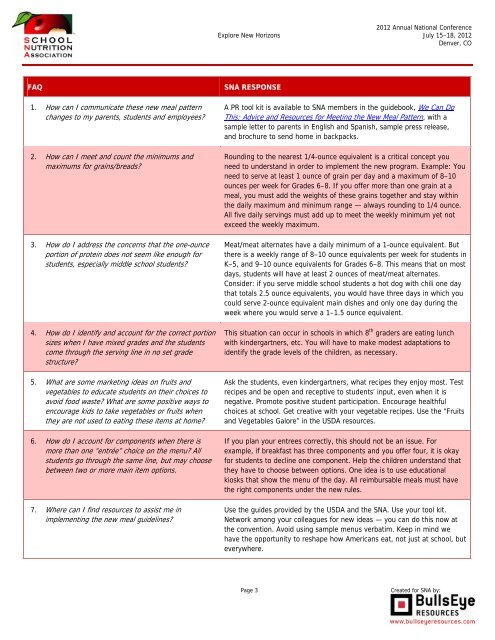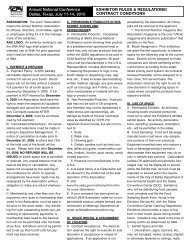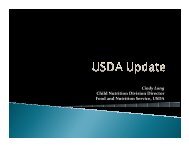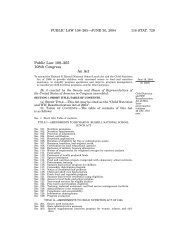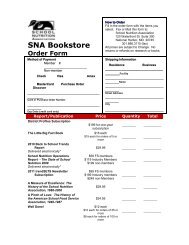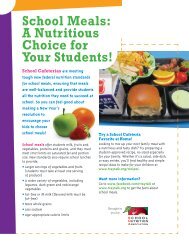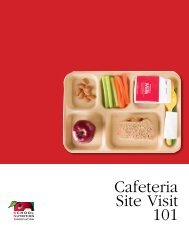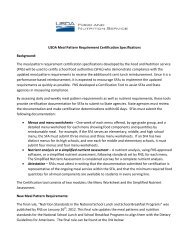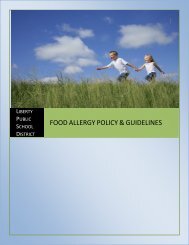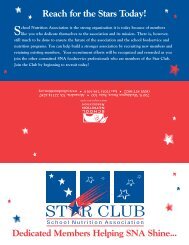Advice and Resources for Meeting the NSLP New Meal Pattern
Advice and Resources for Meeting the NSLP New Meal Pattern
Advice and Resources for Meeting the NSLP New Meal Pattern
You also want an ePaper? Increase the reach of your titles
YUMPU automatically turns print PDFs into web optimized ePapers that Google loves.
2012 Annual National Conference<br />
Explore <strong>New</strong> Horizons July 15–18, 2012<br />
Denver, CO<br />
FAQ<br />
1. How can I communicate <strong>the</strong>se new meal pattern<br />
changes to my parents, students <strong>and</strong> employees?<br />
2. How can I meet <strong>and</strong> count <strong>the</strong> minimums <strong>and</strong><br />
maximums <strong>for</strong> grains/breads?<br />
3. How do I address <strong>the</strong> concerns that <strong>the</strong> one-ounce<br />
portion of protein does not seem like enough <strong>for</strong><br />
students, especially middle school students?<br />
4. How do I identify <strong>and</strong> account <strong>for</strong> <strong>the</strong> correct portion<br />
sizes when I have mixed grades <strong>and</strong> <strong>the</strong> students<br />
come through <strong>the</strong> serving line in no set grade<br />
structure?<br />
5. What are some marketing ideas on fruits <strong>and</strong><br />
vegetables to educate students on <strong>the</strong>ir choices to<br />
avoid food waste? What are some positive ways to<br />
encourage kids to take vegetables or fruits when<br />
<strong>the</strong>y are not used to eating <strong>the</strong>se items at home?<br />
6. How do I account <strong>for</strong> components when <strong>the</strong>re is<br />
more than one “entrée” choice on <strong>the</strong> menu? All<br />
students go through <strong>the</strong> same line, but may choose<br />
between two or more main item options.<br />
7. Where can I find resources to assist me in<br />
implementing <strong>the</strong> new meal guidelines?<br />
SNA RESPONSE<br />
A PR tool kit is available to SNA members in <strong>the</strong> guidebook, We Can Do<br />
This: <strong>Advice</strong> <strong>and</strong> <strong>Resources</strong> <strong>for</strong> <strong>Meeting</strong> <strong>the</strong> <strong>New</strong> <strong>Meal</strong> <strong>Pattern</strong>, with a<br />
sample letter to parents in English <strong>and</strong> Spanish, sample press release,<br />
<strong>and</strong> brochure to send home in backpacks.<br />
Rounding to <strong>the</strong> nearest 1/4-ounce equivalent is a critical concept you<br />
need to underst<strong>and</strong> in order to implement <strong>the</strong> new program. Example: You<br />
need to serve at least 1 ounce of grain per day <strong>and</strong> a maximum of 8–10<br />
ounces per week <strong>for</strong> Grades 6–8. If you offer more than one grain at a<br />
meal, you must add <strong>the</strong> weights of <strong>the</strong>se grains toge<strong>the</strong>r <strong>and</strong> stay within<br />
<strong>the</strong> daily maximum <strong>and</strong> minimum range — always rounding to 1/4 ounce.<br />
All five daily servings must add up to meet <strong>the</strong> weekly minimum yet not<br />
exceed <strong>the</strong> weekly maximum.<br />
Meat/meat alternates have a daily minimum of a 1-ounce equivalent. But<br />
<strong>the</strong>re is a weekly range of 8–10 ounce equivalents per week <strong>for</strong> students in<br />
K–5, <strong>and</strong> 9–10 ounce equivalents <strong>for</strong> Grades 6–8. This means that on most<br />
days, students will have at least 2 ounces of meat/meat alternates.<br />
Consider: if you serve middle school students a hot dog with chili one day<br />
that totals 2.5 ounce equivalents, you would have three days in which you<br />
could serve 2-ounce equivalent main dishes <strong>and</strong> only one day during <strong>the</strong><br />
week where you would serve a 1–1.5 ounce equivalent.<br />
This situation can occur in schools in which 8 th graders are eating lunch<br />
with kindergartners, etc. You will have to make modest adaptations to<br />
identify <strong>the</strong> grade levels of <strong>the</strong> children, as necessary.<br />
Ask <strong>the</strong> students, even kindergartners, what recipes <strong>the</strong>y enjoy most. Test<br />
recipes <strong>and</strong> be open <strong>and</strong> receptive to students’ input, even when it is<br />
negative. Promote positive student participation. Encourage healthful<br />
choices at school. Get creative with your vegetable recipes. Use <strong>the</strong> “Fruits<br />
<strong>and</strong> Vegetables Galore” in <strong>the</strong> USDA resources.<br />
If you plan your entrees correctly, this should not be an issue. For<br />
example, if breakfast has three components <strong>and</strong> you offer four, it is okay<br />
<strong>for</strong> students to decline one component. Help <strong>the</strong> children underst<strong>and</strong> that<br />
<strong>the</strong>y have to choose between options. One idea is to use educational<br />
kiosks that show <strong>the</strong> menu of <strong>the</strong> day. All reimbursable meals must have<br />
<strong>the</strong> right components under <strong>the</strong> new rules.<br />
Use <strong>the</strong> guides provided by <strong>the</strong> USDA <strong>and</strong> <strong>the</strong> SNA. Use your tool kit.<br />
Network among your colleagues <strong>for</strong> new ideas — you can do this now at<br />
<strong>the</strong> convention. Avoid using sample menus verbatim. Keep in mind we<br />
have <strong>the</strong> opportunity to reshape how Americans eat, not just at school, but<br />
everywhere.<br />
Page 3<br />
Created <strong>for</strong> SNA by:


